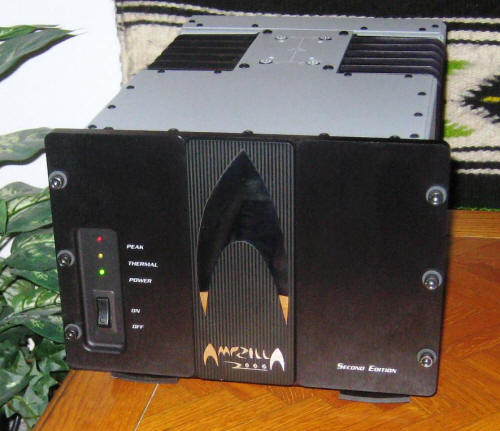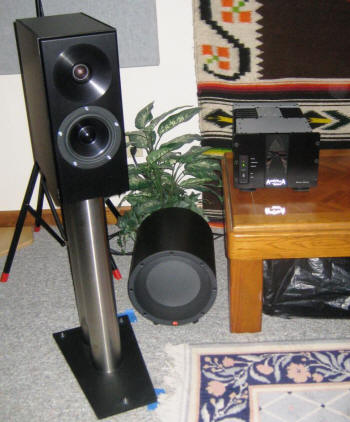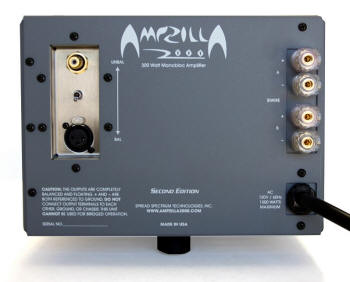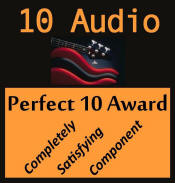When I reviewed the original Ampzilla 2000 monoblock power amplifers in February, 2009, I reported on a very good sounding, well made component that had just enough of its own character that it was highly recommended but not without reservations. In hindsight now, comparing its sound to several other currently made amplifiers, its particular character was quite small and more acceptable than the competition.

The new $8495/pair Ampzilla 2000 Second Edition sees an increase of power from 200 to 300 Watts per channel, while the weight is still very manageable at 52 pounds per chassis. I have had Class D amps that run warmer at low volume levels. When used at high volume levels, the heatsinks get warm. The permanently attached power cord eliminates the option to spend a lot of time and money experimenting with after-market power cords. There are RCA and XLR inputs and 2 pairs of speaker binding posts on each amplifier. There is no remote trigger, and I use a PS Audio Quintet to turn on and turn off the amplifiers remotely. The design is solid industrial but not at all cheap looking. Almost the entire front half of the chassis is taken up by a massive 1200VA power transformer.
My pair (owned, not borrowed or loaned) has a black faceplate and grey chassis. I was a little concerned about the large reflective “A” logo on the front panel. You know, the big Star Trek-looking insignia. This is not a problem, eyesore, intrusion, or distraction. With the amplifiers near the speakers, the reflection from this logo is just black and is only noticeable if I look directly at them. I actually like it. So no worries on that score.
Other components on hand during the audition included a SOTA Cosmos IV vacuum turntable with Triplanar VII u2 tonearm, Basis 2500 Signature turntable with Vector 4 and MØRCH DP-8 tonearms, Miyajima Kansui and Shilabe phono cartridges, Benz LP-S, ZYX Omega-S and UNIverse phono cartridges, Whest PS.30RDT Special Edition phono preamplifier, Bob’s Devices CineMag 1131 “Blue” step-up transformer, Mark Levinson 326S preamplifier with phono, Prism Orpheus Digital Interface and Berkeley Alpha DAC Series 2 with custom Windows 7 computer/music server, KingRex UC384 24bit 384kHz USB to SPDIF digital to digital converter, YG Acoustics Kipod II Signature Main Modules speakers, Dali Mentor 5 speakers (from the home theater system), and Gallo TR-3 subwoofers. Power amplifiers included Mark Levinson 532H, Modwright KWA 150 Signature Edition, Manley Snappers, and Classe CT-M300s. Interconnects and speaker cables are mostly Mogami. All front end components receive their AC power from a PS Audio AV-5000 power conditioner which is connected to the wall power with either PS Audio PerfectWave AC-10 power cord or Shunyata Python CX power cord. Other Shunyata Python CX and Black Mamba CX power cords are used elsewhere in the system, and I use Jerry’s DIY power cords on the music computer and Levinson preamp. A PS Audio Quintet is normally used for the power amplifiers.

The small character I noticed in the original version of the Ampzilla 2000 is gone. That trace of forwardness in the upper midrange has been completely and utterly banished. With a signal/noise spec of -120dB, excellent low level resolution is assured. Given that the main speakers used for this review were the absolutely state-of-the-art, laboratory grade YG Acoustics Kipod II Signatures, I offer the following:
When I hear any sense of uneven frequency balance, where one part of the audible frequency spectrum is either forward or recessed, I will let you know.
When I hear any hint of uneven harmonic balance, such as a “thin” or threadbare sound in one part of the overall sound, for example, a rich and dense midrange with a thin treble, I will let you know.
When I hear complex music become congested or confused, I will let you know.
When I hear the soundstage offer less than outstanding width, depth, and height, I will let you know.
When I hear the sound field miss the ambience and overall size of the recording venue, I will let you know.
When I hear individual performers become flat “cardboard cutouts” or vague sources of sound, I will let you know.
When I hear these amplifiers have any sense of the negative connotations of “solid-state sound”, I will let you know.
In other words, when I hear these remarkable amplifiers doing anything – and I mean anything – wrong, I will let you know.

Hear ye, Hear ye! This is a game changing product. Vacuum tubes sound nice, but you will hear in short order how that “tube sound” really is a form of distortion that colors the music, giving it a false golden hue, obscuring and coloring upper frequency detail, and of course, reducing the resolution and impact in the bass. ALL of the sweet detail in the midrange and treble that we hear from good tube amplifiers is fully present with the Ampzillas, but without unwanted and incorrect additional baggage. Give these SST amps 200-300 hours of break in and your tube amps will be looking for a new home. And if you are like me, you will not miss wondering if your tube amps are going to blow a tube when you turn them on, harming your anticipated listening session. You will not miss that!
As I typed the preceeding paragraph I realized that the natural comparison for the solid-state Ampzilla 2nd Edition amplifiers is not to other solid-state amplifiers, but to vacuum tube amplifiers with their natural and lifelike sound. We take for granted the tubes’ wonderful harmonic depth and realistic presentation of voices and acoustic instruments, while accepting their almost universal weaknesses in the bass and upper treble. Eliminate those weaknesses, plus those noted above, and you have the Second Edition Ampzillas.
I am using my system much more since I installed the Ampzilla amplifiers several months ago. I don’t worry about “wasting” costly vacuum tubes with background music. I don’t worry about the electric bill with these running all day because they use only about 0.6 Amps (each chassis) at low volume levels. Compare that to the Parasound JC-1 which draws 4.8 Amps at LOW bias, or Krell FPB-300cx at 4.5 Amps. And most of all, I am not thinking about my next amplifier! The amplifiers have operated perfectly without any faults or strange behavior since installed.
The Spread Spectrum Technologies Ampzilla 2000 Second Edition power amplifiers are the most neutral and enjoyable sounding amps I have heard in my systems. My perfect amplifier would offer faultless sound, be affordable and easy to install, not heat the room, have no ongoing maintenance, and be inexpensive to operate. I believe that amplifier is in my listening room right now! If you are shopping in the $20k plus range, you will ignore these no matter how good they sound. For the rest of us, these are happy days! Live long and prosper.
Overall Rating: 10 LPs

Link to manufacturer’s Web site: Spread Spectrum Technologies
My thanks to Walter Liederman at Underwood Hi-Fi. This review would not have been possible without Walter’s kind assistance.
